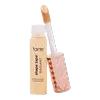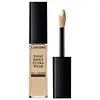What's inside
What's inside
 Key Ingredients
Key Ingredients

 Benefits
Benefits

 Concerns
Concerns

 Ingredients Side-by-side
Ingredients Side-by-side

Water
Skin ConditioningButylene Glycol
HumectantButylene Glycol Dicaprylate/Dicaprate
EmollientDipropylene Glycol
HumectantHydrogenated Polydecene
EmollientPhenyl Trimethicone
Skin ConditioningPolyglyceryl-4 Diisostearate/Polyhydroxystearate/Sebacate
EmulsifyingGlycerin
HumectantDibutyl Adipate
EmollientDiisostearyl Malate
EmollientHydrogenated Castor Oil Isostearate
Skin ConditioningSqualane
EmollientTridecyl Trimellitate
EmollientDimethicone
EmollientMica
Cosmetic ColorantCaprylic/Capric Triglyceride
MaskingMagnesium Sulfate
Polyglyceryl-3 Oleate
EmulsifyingDiamond Powder
AbrasiveHippophae Rhamnoides Fruit Oil
Skin ProtectingHippophae Rhamnoides Seed Oil
Skin ProtectingNiacinamide
SmoothingCamellia Sinensis Leaf Extract
AntimicrobialHydrolyzed Collagen
EmollientCentella Asiatica Extract
CleansingGlycyrrhiza Glabra Root Extract
BleachingOpuntia Vulgaris Extract
Skin ConditioningPanax Ginseng Root Extract
EmollientSodium Hyaluronate
HumectantSynthetic Fluorphlogopite
Disteardimonium Hectorite
StabilisingDiisostearoyl Polyglyceryl-3 Dimer Dilinoleate
EmollientEthylene/Propylene Copolymer
AbrasiveVinyl Dimethicone/Methicone Silsesquioxane Crosspolymer
Dimethicone/Vinyl Dimethicone Crosspolymer
Skin ConditioningSynthetic Beeswax
Emulsion StabilisingTriethoxycaprylylsilane
Aluminum Hydroxide
EmollientSodium Benzoate
MaskingPotassium Sorbate
PreservativeTrisodium Ethylenediamine Disuccinate
Ethylhexylglycerin
Skin ConditioningTin Oxide
AbrasiveGlycine Soja Oil
Emollient1,2-Hexanediol
Skin ConditioningPolymethylsilsesquioxane
Benzyl Salicylate
PerfumingHexyl Cinnamal
PerfumingLimonene
PerfumingHydroxycitronellal
PerfumingGeraniol
PerfumingAmyl Cinnamal
PerfumingLinalool
PerfumingTocopherol
AntioxidantPhenoxyethanol
PreservativeParfum
MaskingCI 77891
Cosmetic ColorantIron Oxides
Water, Butylene Glycol, Butylene Glycol Dicaprylate/Dicaprate, Dipropylene Glycol, Hydrogenated Polydecene, Phenyl Trimethicone, Polyglyceryl-4 Diisostearate/Polyhydroxystearate/Sebacate, Glycerin, Dibutyl Adipate, Diisostearyl Malate, Hydrogenated Castor Oil Isostearate, Squalane, Tridecyl Trimellitate, Dimethicone, Mica, Caprylic/Capric Triglyceride, Magnesium Sulfate, Polyglyceryl-3 Oleate, Diamond Powder, Hippophae Rhamnoides Fruit Oil, Hippophae Rhamnoides Seed Oil, Niacinamide, Camellia Sinensis Leaf Extract, Hydrolyzed Collagen, Centella Asiatica Extract, Glycyrrhiza Glabra Root Extract, Opuntia Vulgaris Extract, Panax Ginseng Root Extract, Sodium Hyaluronate, Synthetic Fluorphlogopite, Disteardimonium Hectorite, Diisostearoyl Polyglyceryl-3 Dimer Dilinoleate, Ethylene/Propylene Copolymer, Vinyl Dimethicone/Methicone Silsesquioxane Crosspolymer, Dimethicone/Vinyl Dimethicone Crosspolymer, Synthetic Beeswax, Triethoxycaprylylsilane, Aluminum Hydroxide, Sodium Benzoate, Potassium Sorbate, Trisodium Ethylenediamine Disuccinate, Ethylhexylglycerin, Tin Oxide, Glycine Soja Oil, 1,2-Hexanediol, Polymethylsilsesquioxane, Benzyl Salicylate, Hexyl Cinnamal, Limonene, Hydroxycitronellal, Geraniol, Amyl Cinnamal, Linalool, Tocopherol, Phenoxyethanol, Parfum, CI 77891, Iron Oxides
Water
Skin ConditioningUndecane
EmollientDimethicone
EmollientGlycerin
HumectantTridecane
PerfumingPolyglyceryl-4 Isostearate
EmulsifyingPentylene Glycol
Skin ConditioningCetyl PEG/PPG-10/1 Dimethicone
EmulsifyingHexyl Laurate
EmollientMagnesium Sulfate
Disteardimonium Hectorite
StabilisingRosa Gallica Flower Extract
AstringentHelianthus Annuus Seed Oil
EmollientMoringa Oleifera Seed Extract
Skin ConditioningNymphaea Alba Flower Extract
Skin ConditioningIsobutane
Sorbitol
HumectantTrihydroxystearin
Skin ConditioningCellulose Gum
Emulsion StabilisingAluminum Hydroxide
EmollientDisodium Phosphate
BufferingDisodium Stearoyl Glutamate
CleansingPropanediol
SolventPropylene Glycol
HumectantCitric Acid
BufferingAcetylated Glycol Stearate
EmollientEthylhexylglycerin
Skin ConditioningAcrylonitrile/Methyl Methacrylate/Vinylidene Chloride Copolymer
Tocopherol
AntioxidantPentaerythrityl Tetra-Di-T-Butyl Hydroxyhydrocinnamate
AntioxidantPhenoxyethanol
PreservativeWater, Undecane, Dimethicone, Glycerin, Tridecane, Polyglyceryl-4 Isostearate, Pentylene Glycol, Cetyl PEG/PPG-10/1 Dimethicone, Hexyl Laurate, Magnesium Sulfate, Disteardimonium Hectorite, Rosa Gallica Flower Extract, Helianthus Annuus Seed Oil, Moringa Oleifera Seed Extract, Nymphaea Alba Flower Extract, Isobutane, Sorbitol, Trihydroxystearin, Cellulose Gum, Aluminum Hydroxide, Disodium Phosphate, Disodium Stearoyl Glutamate, Propanediol, Propylene Glycol, Citric Acid, Acetylated Glycol Stearate, Ethylhexylglycerin, Acrylonitrile/Methyl Methacrylate/Vinylidene Chloride Copolymer, Tocopherol, Pentaerythrityl Tetra-Di-T-Butyl Hydroxyhydrocinnamate, Phenoxyethanol
 Reviews
Reviews

Ingredients Explained
These ingredients are found in both products.
Ingredients higher up in an ingredient list are typically present in a larger amount.
Aluminum Hydroxide is a form of aluminum. It can be naturally found in nature as the mineral gibbsite. In cosmetics, Aluminum Hydroxide is used as a colorant, pH adjuster, and absorbent.
As a colorant, Aluminum Hydroxide may add opacity, or reduce the transparency. Aluminum hydroxide is contains both basic and acidic properties.
According to manufacturers, this ingredient is an emollient and humectant. This means it helps hydrate the skin.
In medicine, this ingredient is used to help relieve heartburn and help heal ulcers.
There is currently no credible scientific evidence linking aluminum hydroxide in cosmetics to increased cancer risk.
Major health organizations allow the use of aluminum hydroxide in personal care products and have not flagged it as a carcinogenic risk at typical usage levels.
Learn more about Aluminum HydroxideDimethicone is a type of synthetic silicone created from natural materials such as quartz.
What it does:
Dimethicone comes in different viscosities:
Depending on the viscosity, dimethicone has different properties.
Ingredients lists don't always show which type is used, so we recommend reaching out to the brand if you have questions about the viscosity.
This ingredient is unlikely to cause irritation because it does not get absorbed into skin. However, people with silicone allergies should be careful about using this ingredient.
Note: Dimethicone may contribute to pilling. This is because it is not oil or water soluble, so pilling may occur when layered with products. When mixed with heavy oils in a formula, the outcome is also quite greasy.
Learn more about DimethiconeDisteardimonium Hectorite comes from the clay mineral named hectorite. It is used to add thickness to a product.
It can also help stabilize a product by helping to disperse other ingredients.
Hectorite is a rare, white clay mineral.
Learn more about Disteardimonium HectoriteEthylhexylglycerin (we can't pronounce this either) is commonly used as a preservative and skin softener. It is derived from glyceryl.
You might see Ethylhexylglycerin often paired with other preservatives such as phenoxyethanol. Ethylhexylglycerin has been found to increase the effectiveness of these other preservatives.
Glycerin is already naturally found in your skin. It helps moisturize and protect your skin.
A study from 2016 found glycerin to be more effective as a humectant than AHAs and hyaluronic acid.
As a humectant, it helps the skin stay hydrated by pulling moisture to your skin. The low molecular weight of glycerin allows it to pull moisture into the deeper layers of your skin.
Hydrated skin improves your skin barrier; Your skin barrier helps protect against irritants and bacteria.
Glycerin has also been found to have antimicrobial and antiviral properties. Due to these properties, glycerin is often used in wound and burn treatments.
In cosmetics, glycerin is usually derived from plants such as soybean or palm. However, it can also be sourced from animals, such as tallow or animal fat.
This ingredient is organic, colorless, odorless, and non-toxic.
Glycerin is the name for this ingredient in American English. British English uses Glycerol/Glycerine.
Learn more about GlycerinMagnesium Sulfate is a salt. More specifically, it is an epsom salt, or the bath salt used to help relieve muscle aches.
Despite having ‘sulfate’ in the name, it isn’t a surfactant or cleansing agent like sodium lauryl sulfate. Unlike those sulfates, magnesium sulfate doesn’t have the same cleansing or foaming properties (it's simply a type of salt).
In cosmetics, Magnesium Sulfate is used to thicken a product or help dilute other solids. It is a non-reactive and non-irritating ingredient.
One study shows magnesium deficiency may lead to inflammation of the skin. Applying magnesium topically may help reduce inflammation.
You can find this ingredient in sea water or mineral deposits.
Learn more about Magnesium SulfatePhenoxyethanol is a preservative that has germicide, antimicrobial, and aromatic properties. Studies show that phenoxyethanol can prevent microbial growth. By itself, it has a scent that is similar to that of a rose.
It's often used in formulations along with Caprylyl Glycol to preserve the shelf life of products.
Tocopherol (also known as Vitamin E) is a common antioxidant used to help protect the skin from free-radicals and strengthen the skin barrier. It's also fat soluble - this means our skin is great at absorbing it.
Vitamin E also helps keep your natural skin lipids healthy. Your lipid skin barrier naturally consists of lipids, ceramides, and fatty acids. Vitamin E offers extra protection for your skin’s lipid barrier, keeping your skin healthy and nourished.
Another benefit is a bit of UV protection. Vitamin E helps reduce the damage caused by UVB rays. (It should not replace your sunscreen). Combining it with Vitamin C can decrease sunburned cells and hyperpigmentation after UV exposure.
You might have noticed Vitamin E + C often paired together. This is because it is great at stabilizing Vitamin C. Using the two together helps increase the effectiveness of both ingredients.
There are often claims that Vitamin E can reduce/prevent scarring, but these claims haven't been confirmed by scientific research.
Learn more about TocopherolWater. It's the most common cosmetic ingredient of all. You'll usually see it at the top of ingredient lists, meaning that it makes up the largest part of the product.
So why is it so popular? Water most often acts as a solvent - this means that it helps dissolve other ingredients into the formulation.
You'll also recognize water as that liquid we all need to stay alive. If you see this, drink a glass of water. Stay hydrated!
Learn more about Water